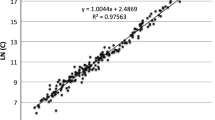Abstract
Significant discrepancies were found in the ratio and relative impact of the journal papers of several scientific fields of some Central and Eastern European (CEE) countries compared to the European Community member states, the US and Japan (EUJ countries). A new indicator, characterizing the Mean Structural Difference of scientific fields between countries has been introduced and calculated for CEE countries. For EUJ countries correlation between the GDP and number of publications of a given year proved to be non-significant. Longitudinal studies showed, however, significant correlations between the yearly values of GDP and number of papers published. Studying data referring to consecutive time periods revealed that there is no direct relationship between the GDP and information production of countries. It may be assumed that grants for R&D do not actually depend on real needs, but the fact is that rich countries can afford to spend more whilst poor countries only less money on scientific research.
Similar content being viewed by others
References
Archibugi, D., Coco, A. (2004), A new indicator of technological capabilities for developed and developing countries (ArCo). World Development, 32: 629–654.
Braun, T., Schubert, A. (1988), World flash on basic research. Scientometric versus socio-economic indicators. Scatter plots for 51 countries, Scientometrics, 13: 3–9.
Kealey, T. (1996), The Economic Laws of Scientific Research, St. Martin’s Press, New York.
King, D. A. (2004), The scientific impact of nations. What different countries get for their research spending, Nature, 430: 311–316.
De Moya-Anegón, F., Herrero-Solana, V. (1999), Science in America Latina: A comparison of bibliometric and scientific-technical indicators, Scientometrics, 46: 299–320.
Must, Ü. (2006), “New” countries in Europe — Research, development and innovation strategies vs bibliometric data, Scientometrics, 66: 241–248.
Narin, F., Hamilton, K. S., Olivastro, D. (1997), The increasing linkage between U.S. technology and public science, Research Policy, 26: 317–330.
Price, De Solla (1978), Toward a model for science indicators, In: Elkana Y., Lederberg J., Merton R. K., Thackray A., Zuckerman H. (Eds), Toward a Metric of Science: The Advent of Science Indicators. John Wiley & Sons, New York, pp. 69–95.
Rai, L. P., Lal, K. Indicators of the information revolution, Technology in Society, 22: 221–235.
Schubert, A., Glänzel, W., Braun, T. (1989), Scientometric datafiles. A comprehensive set of indicators on 2649 journals and 96 countries in all major science fields and subfields 1981–1985, Scientometrics, 16: 3–478.
Sorenson, O., Fleming, L. (2004), Science and the diffusion of knowledge, Research Policy, 33: 1615–1634.
Vinkler, P. (1992), Research policy and publication productivity. In: Representations of Science and Technology, Proceedings of the International Conference on Science and Technology Indicators, Bielefeld, DSWO Press, Leiden University, pp. 75–91.
Vinkler, P. (2002), The institutionalization of scientific information: A scientometric model (ISI-S Model), Library Trends, 50: 553–569.
Vinkler, P. (2003), Relations of relative scientometric indicators, Scientometrics, 58: 687–694.
Vinkler, P. (2004), Characterization of the impact of sets of scientific papers: The Garfield (Impact) Factor, Journal of the American Society for Information Science and Technology, 55: 431–435.
Vinkler, P. (2005), Science indicators, economic development and the wealth of nations, Scientometrics, 63: 417–419.
Author information
Authors and Affiliations
Corresponding author
Rights and permissions
About this article
Cite this article
Vinkler, P. Correlation between the structure of scientific research, scientometric indicators and GDP in EU and non-EU countries. Scientometrics 74, 237–254 (2008). https://doi.org/10.1007/s11192-008-0215-z
Received:
Published:
Issue Date:
DOI: https://doi.org/10.1007/s11192-008-0215-z




